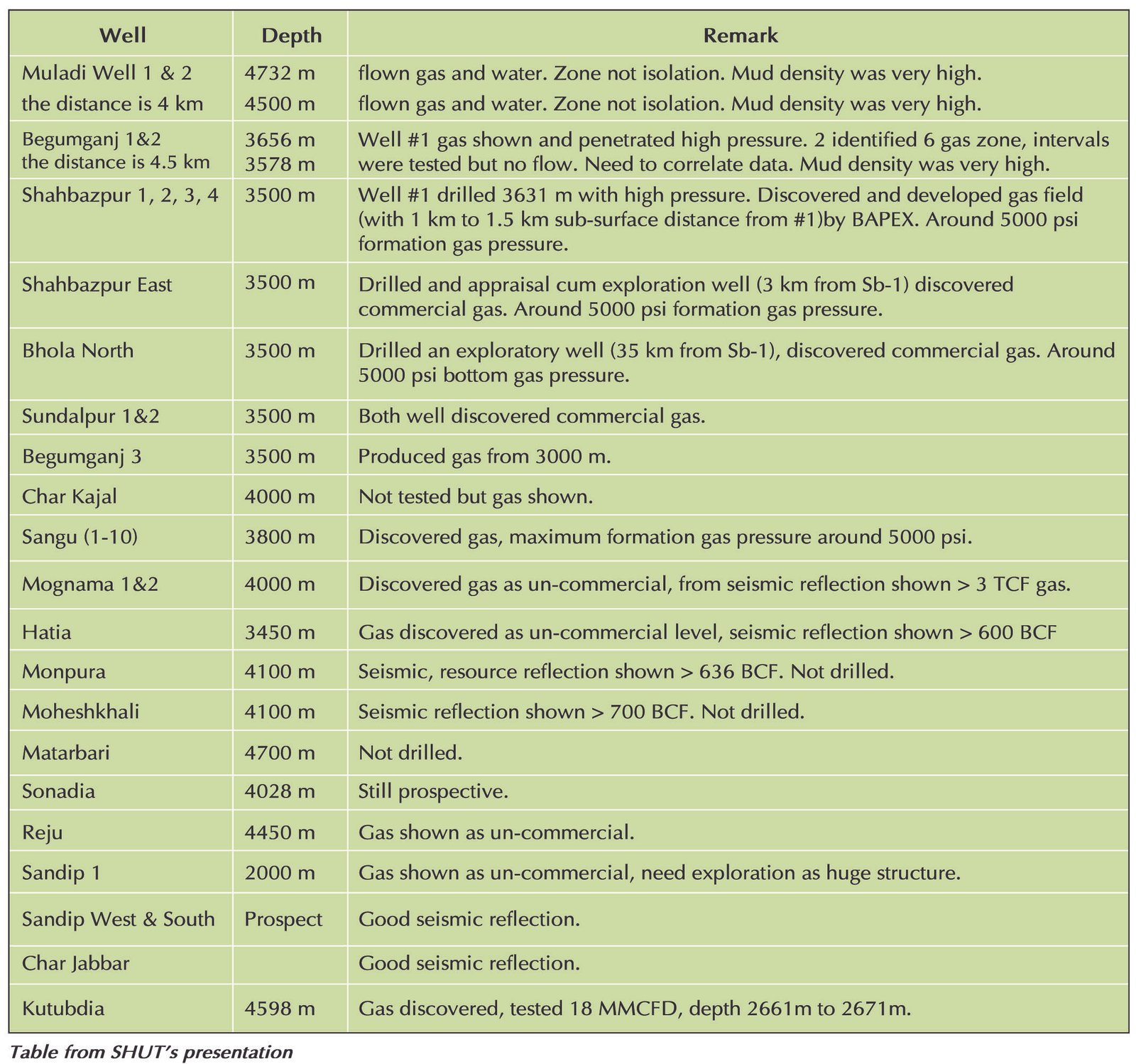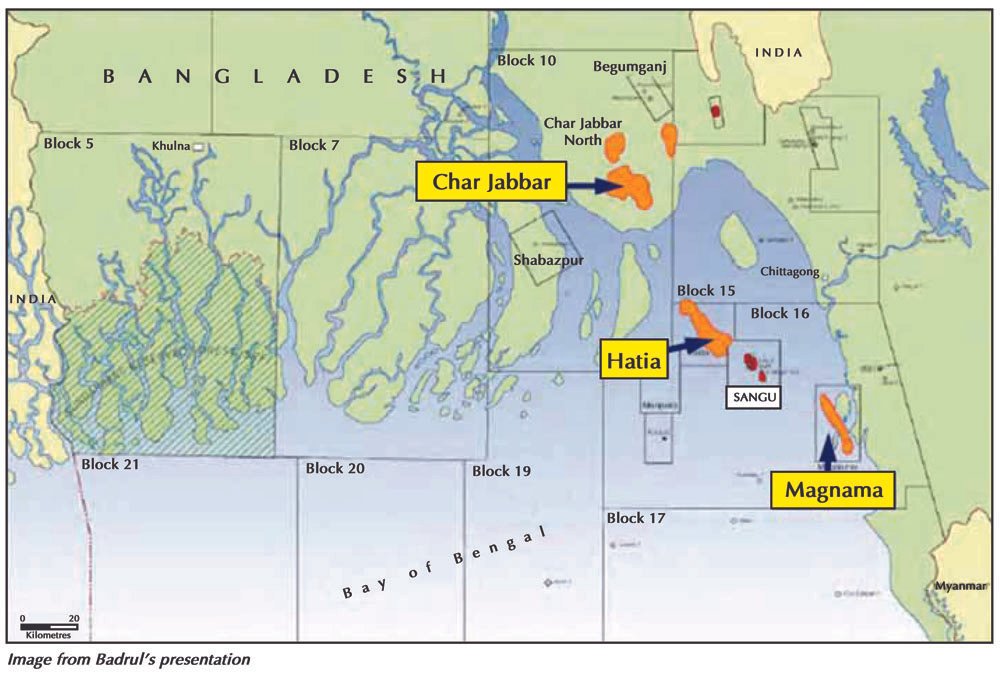
The gas reserves in a single field of Bhola Island might exceed the reserves of Titas or Bibiyana having more than seven trillion cubic feet while Bangladesh left a good number of gas prospects due to their complex nature.
As the largest gas field of Bangladesh, Titas has reserves of approximately 7.0 TCF while the second largest field Bibiyana has reserves of more than 4.5 TCF.
Russia’s oil and gas exploration and supply company, Gazprom, at a seminar in Dhaka on March 3 claimed the hydrocarbon prospects in Bhola as they estimated that the newly discovered gas field has the same structure of the Shahbazpur gas field, some 35 kilometers off it.
In his keynote presentation, Dhaka University geology professor Badrul Imam said Bangladesh remained one of the least explored petroleum ‘provinces’ in the world as the attempts made so far targeted only the simple and easy drilling prospects.

Forum for Energy Reporters Bangladesh (FERB) organized the seminar, after the government-claimed discovery of a gas field with 600 billion cubic feet of gas reserve and identifying increase of Shahbazpur gas field’s reserve to 900 bcf in Bhola in last four months.
Prime Minister’s energy adviser Tawfiq-e-Elahi Chowdhury chaired the seminar while former managing director of Bapex Amzad Hossain, Dhaka University geology department’s chairman Kazi Matin Uddin Ahmed and the university’s teachers’ association president ASM Maksud Kamal addressed the seminar.
Bapex, the Bangladesh Petroleum Exploration and Production Company, claimed in late October 2018 an increase of gas reserves at Shahbazpur field to at least 900 billion cubic feet from its previous estimate of around 500 BCF after drilling an appraisal well 3.5km off the center of the field.
Bapex in early January also claimed the discovery of a fresh gas field after drilling exploration well 35km off the Shahbazpur field. Being engaged by the Bapex, Gazprom drilled the two wells in Bhola.
In a paper presented by Gazprom’s country representative in Bangladesh Nikita SHUT said, “There is a possibility that the volume of gas reserves in place may exceed the current estimate. If this assumption is confirmed, the Bhola gas field would be bigger than either the Titas or Bibiyana gas field.”
He suggested taking more drilling programs in Bhola in the shortest possible time to estimate the size of the structure and the potential gas reserves.
In his paper, Badrul Imam said that huge potentials for oil and gas remained unexplored in the onshore and offshore areas, leaving Bangladesh one of the least explored countries in the world.
Some 70 exploration wells have been drilled in Bangladesh in the last one century with an exploration well density at one per 2,215 square kilometers while the density is even worse in the offshore areas with one well per 5,000 square kilometers.
Badrul said that the United States of America in the Gulf of Mexico drilled such exploration wells at the rate of one per 14 square kilometers while India drilled at the rate of one per 146 square kilometers in its offshore areas.

Bangladesh has so far drilled only 19 wells in its vast offshore areas, he said, adding that the country’s largest gas structures like Bandarbans with more than 1,000 square kilometers and Sitakund with 350 square kilometers are left unexplored.
At the seminar, former managing director of Bapex Amzad Hossain said that the world’s one-third gas was extracted from ‘tight gas sand’ while in Bangladesh the prospect was completely unexplored.
Amzad and Badrul pointed out that there were good number of attempts abandoned, including that at Sitapahar, due to high pressure of the gas.
Tawifq said that the government’s efforts could hardly attract the international oil companies in the past few years due to global economic downturn.
He was hopeful about changing the scenario in the near future with the government’s program of drilling 108 wells with more than 50 exploration ones in five years.
Badrul, however, warned that drilling 10 exploration wells a year was an over ambitious notion in the context of Bangladesh and may lead to some unnecessary dry holes.
He suggested to go slow and steady with the government’s drilling program, ‘Rupkolpa’, with in depth evaluation of the prospects to launch drilling, rather than out-stepping in a hurry.
Tawfiq also said that Bapex with the help of Gazprom could go for offshore exploration.
The role of Gazprom, however, drew severe criticism as it had charged much higher prices for drilling wells with very poor outputs than the other IOCs in the country.
Gazprom drilled 15 gas wells before drilling the two in Bhola.
Prospects Kept Waiting for Exploration
Badrul in his paper said that revisiting the database of earlier wells drilled and abandoned in the southern coastal areas showed that they were not dry, but showed the signs of gas flow.
He attributed the negative results and being abandoned of the attempts to overbalanced mud (Patiya well and Jaldi well), unwillingness to extract gas from tight sands (Char Kajol well), peripheral well (Hatiya well), improper location (Sitakund well), incomplete testing (Muladi well) and so on.
Badrul is hopeful of discovering gas fields in the previously declared dry wells if retesting and/or carrying out drilling programs in the prospects with appropriate technology.
Structures like Magnama in the shallow waters and Moheshkhali near Teknaf of Cox’s Bazar, Hatia Island in Noakhali and Monpura in Bhola have a combined prospect of nearly five trillion cubic feet of gas reserves which have been left along with some other prospects in the country’s southern districts, according to the papers presented by SHUT and Badrul.
Badrul claimed that Char Jabbar, Char Jabbar north, Monpura, Moheshkhali, Sandwip W and Sandwip S were structural prospects and recommended carrying out 3D seismic interpretation in those areas before marking location for drilling exploration wells.
He said that gas extraction through fracturing ‘tight sand’ was possible at Chal Kajol although Chevron in 2010 abandoned an exploration well after finding a 30- meter ‘gross pay sand’ (tight formation with low permeability).
Badrul also recalled some historic failed attempts like Muladi well drilled between 1977 and 1981 giving indication of several gas zones. Patiya well drilled in 1953 by Pakistan Petroleum Limited and Jaldi well drilled in 1965 drilled by Oil and Gas Development Co Ltd were abandoned due to overbalanced mud although they showed strong presence of gas. Sitapahar well drilled in 1988 by Shell Oil Co was abandoned after a gas blowout due to overpressure gas flow.
He is also optimistic about the thin bed prospects, overpressure prospect and synclinal prospects that require active evaluations.



